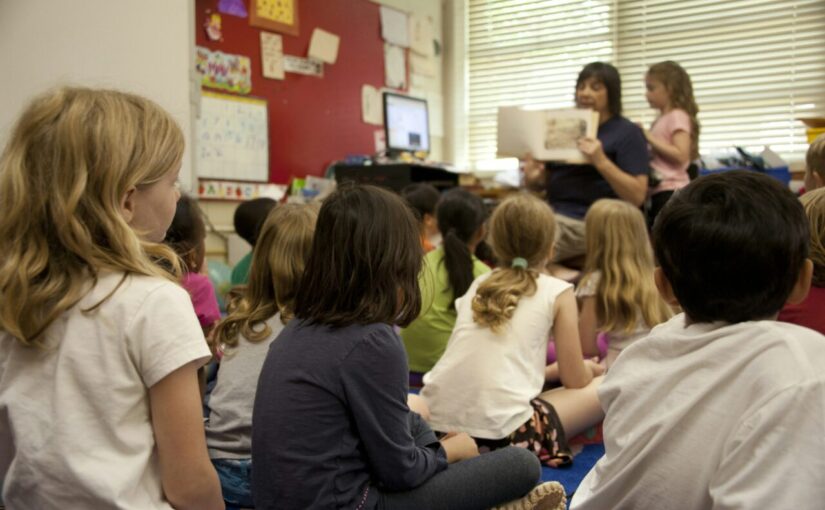Dr Saba Joshi, Lecturer in Gender and Development at the Department of Politics and Deputy Director of the IGDC, explores the gendered dimensions of the chronic underfunding and devaluation of paid and unpaid care work in global economies in a report recently published for Education International, a global union federation of teachers’ trade unions.
The global pandemic that swept across the world just a few years ago was a grim reminder of the fragility of human lives. Widespread illness and death, economic disruption, mobility restrictions and lockdowns precipitated by the unabated spread of Covid-19, was shocking, almost unbelievable for many of us.
At its crux, the pandemic sent a stark message about the significance of our health and wellbeing for the functioning of our societies and economies. Ultimately, what contributed disproportionately to our survival during this unprecedented event was “care”.
Care, in this context, refers to the life enhancing labour done “in part as unpaid work by families, friends, and community members, and in part as paid labour by workers such as doctors, nurses, teachers, home healthcare workers, nannies and domestic workers.”1
Despite its centrality to our lives, care work is often a complex subject to grapple. How is care work of economic significance? How does care work impact upon individual workers’ lives? What challenges do care workers face globally? And how do these questions relate to education professionals, who work in a key sector of the global care economy? This blog piece will address some of these questions, with a global focus on gender and the education sector.
What is the care economy and why gender matters
Care work refers to the complex web of activities that sustain and reproduce life. Such work is wide-ranging and crucially, underpins all economic activity. Taken together, the term “care economy” captures to the relationship between economic and reproductive activities that sustain human societies.
One striking feature of the care economy is that it includes both unpaid and paid forms of labour. The work done by early childhood education and care personnel and schoolteachers, healthcare professionals, cleaners, and other household service providers are paid forms of care labour. At the same time, the time and energy spent on household tasks such as cooking, cleaning, and washing performed for oneself and others can be both paid and unpaid domestic labour.
It is impossible to talk about the care economy without recognizing the gendered dimension of both paid and unpaid care work. Globally speaking, women perform an inordinate amount of such labour in the world. The United Nations estimates that women carry out at least 2.5 times more unpaid household and care work than men2. Unpaid care labour comprises 41 percent of the total global work hours.3
Paid care work is also dominated by women globally. The International Labour Organization’s (ILO) estimated that in 2018 global care workforce of 381 million workers is comprised of 248.9 million women and 132.1 million men. This implies a feminization rate (number of women per 100 men) of 65.3 percent4. In health-care, the most prominent sector of paid care work, women comprise 70 percent of workers globally5.
Measuring this care labour is complex, but assigning monetary value to it may help us understand its astounding economic contribution. Research indicates that women’s unpaid contributions to care equates to US$11 trillion or approximately 9 percent of the world GDP6.These estimates are based on time-use survey data gathered from 53 countries (63.5 percent of the global working age population) and were valued at the hourly minimum wage of each country.7
Gender, care and education
The education sector is a central pillar in the care economy. In developed economies, where the care workforce tends to be the largest, education and healthcare sectors are sizeable and relatively proportionate. Among poorer countries, care work is generally smaller and is concentrated in education, while healthcare sectors are more minor8.
The education sector is a bigger source of employment for women than for men. Around 7.4 percent of all women employed in the world find jobs in education, compared to 3.1 percent of men9. However there are important regional differences, in Africa and the Arab States, men tend to dominate the education sector overall. In regions where the education sector is larger, such as developed countries, women’s employment also tends to be higher.
Gender dynamics of employment in education are quite closely related to care work. For instance, the concentration of women teachers tend to be in the earlier years of schooling and their share of employment shrinks with each successive level of education10. This suggests that mainstream gender roles that associate women more closely with reproductive work and childcare are mirrored in their workforce participation. This in turn produce inequalities in the way this work is valued.
Early childhood education exemplifies this stark overlap between gendered nature of paid care work and its devaluation. Women make-up 85 percent of pre-primary school (typically between ages 3 and 5 years) teachers in all countries with available data11. ILO analyses find that in both developed and developing countries, the pay and benefits for teachers for early childhood educators overall is lower than teachers at other levels. This has been linked to the high number of women represented in this category, the low recognition of their work and the low rates of unionization12. Education International’s research on early childhood systems in 17 countries from almost all world regions found that early childhood education teachers, particularly in the private sector, remain largely nonunionized (EI, 2010)13.
Understanding the ‘crisis of care’
The ongoing struggles towards achieving gender justice and equitable, healthy, thriving societies are encapsulated in what is often termed the ‘crisis of care’. This crisis, which has long simmered under the societal and economic structures, refers to a) the chronic public underfunding and global devaluation of paid care work in economies, including but not limited to the education sector and b) the unequal participation in unpaid care work, where women and girls carry the largest burden. Undoubtedly, those further marginalised due to class, race, ethnicity, religion, sexuality or migration status, often face worse and more exacerbated impacts of this crisis.
The issue of chronic public underfunding of paid care work should come as no surprise to educators. In figures released by UNESCO in 2023, 9 percent of primary school teachers quit their jobs in 2022 (almost double the rate of 4.6 percent in 2015). According to these data, this trend is also visible among pre-primary school teachers, where the annually a global average of 5 percent of workers leave the profession14. The UN agency estimates that 44 million additional teachers need to be recruited if every child is to be provided education in the world15.
The shortfall of teachers is global—in sub-Saharan Africa there is a need for 15 million teachers to meet Sustainable Development Goal of education for all by 2030 (SDG 4), while in Europe and North America, 4.8 million teachers are needed16. This global shortfall is closely related to the deteriorating conditions, including pay and work-life balance for educators, which can only be ensured through sustained public funding of education. The ILO finds that “between 2005 and 2015, teachers’ statutory salaries decreased in real terms in one-third of the countries with available data.”17.
At the same time, considering women make up much of the education workforce globally, the dynamics of unpaid care labour are of equal importance here. The rising pressure to perform unpaid care labour is an acute problem due to issues such as the lack of affordable childcare and healthcare in many countries.
During the pandemic, lockdowns and other policies restricted worker mobility and the debilitating impacts of unpaid care work on teachers became increasingly visible. Feminist Center for Information and Action’s study of the care crisis for teachers from eight countries in Latin America during the pandemic found that women teachers experienced a “deepening of the care crisis” during the pandemic, with 1 in 4 women teachers stating that the time spent on care labour for non-dependent adults, increased18.
This is in line with EI’s global findings on women union members during the pandemic, which noted that due to increased burden of care work, members “were forced to leave teaching because of the uncertainty of loss of income, not to mention those who left due to stress cause by the shift to online teaching modalities.”19
The quote below from a key informant interviewed in this study, explains the relationship between unpaid care work and teaching during the pandemic:
Single parents are drowning in tasks constantly, no time for anything but childcare, work and housework. Out of hours working, lack of prep time, precarious work, having to cover classes, all of these things existed from before, so women’s lack of equality, but what we saw during the pandemic was that this really impacted members’ mental health.”20
Key Informant – Europe
This statement captures what is at the heart of the crisis of care: the compounding impact of unsustainable working conditions for teachers, and the unjust, unequal burden of care work that disproportionately affects women.
About Education International
Education International is the Global Union Federation that brings together organisations of teachers and other education employees from across the world. It comprises 383 member organisations and represents more than 32 million teachers and education support personnel in 178 countries and territories.
This blog was originally posted on the Education International website.
- Duffy, M., & Armenia, A. (2021). Paid Care Work Around the Globe – A comparative analysis of 47 countries and territories (Discussion Paper 39). UN Women, p.1. ↩︎
- International Labour Office. (2016). Women at work: Trends 2016. International Labour Office.
↩︎ - UN Women. (2020). COVID-19 and the Care Economy: Immediate action and structural transformation for a gender-responsive recovery (Policy Brief 16; Covid Response). UN Women, p.3. ↩︎
- ILO (2018). Care work and care jobs for the future of decent work. International Labour Office, p.168.
↩︎ - UN Women. (2020). COVID-19 and the Care Economy: Immediate action and structural transformation for a gender-responsive recovery (Policy Brief 16; Covid Response). UN Women, p.3. ↩︎
- Ibid ↩︎
- ILO (2018). Care work and care jobs for the future of decent work. International Labour Office, p.49. ↩︎
- Duffy, M., & Armenia, A. (2021). Paid Care Work Around the Globe – A comparative analysis of 47 countries and territories (Discussion Paper 39). UN Women, pp. 8 , 15. ↩︎
- ILO (2018). Care work and care jobs for the future of decent work. International Labour Office, p.185. ↩︎
- OECD. (2019). Education at a Glance 2019: OECD Indicators. OECD. p.436. ↩︎
- ibid ↩︎
- ILO (2018). Care work and care jobs for the future of decent work. International Labour Office, p.188. ↩︎
- (2010). Early Childhood Education: A Global Scenario. Education International. ↩︎
- UNESCO. (2023). The teachers we need for the education we want: The global imperative to reverse the teacher shortage; factsheet. UNESCO, p.36. ↩︎
- UNESCO. (2023). The teachers we need for the education we want: The global imperative to reverse the teacher shortage; factsheet. UNESCO ↩︎
- Ahmed, K. (2023, October 4). World needs 44m more teachers in order to educate every child, report finds. The Guardian. ↩︎
- ILO (2018). Care work and care jobs for the future of decent work. International Labour Office, p.129. ↩︎
- Feminist Center for Information and Action CEFEMINA. (2022). Who is going to foot the bill?: Loss of labor rights and deepening of the care crisis for women teachers in eight Latin American countries during the pandemic. Education International Latin America. ↩︎
- Miller, C., & Sabra, H. (2022). Women’s Participation in Education Unions in a Time of Covid-19 [Education International Research]. Education International, p.10 ↩︎
- Miller, C., & Sabra, H. (2022). Women’s Participation in Education Unions in a Time of Covid-19 [Education International Research]. Education International, p.11 ↩︎

